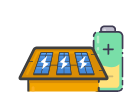The next big challenge – solar energy storage
Solar energy storage is the next big problem for the global solar PV sector, but it is also a crucial one. As with electric vehicles, the future seems to lie in the realm of lithium-ion batteries and a burgeoning market lies in wait for investors.
Without the means to store solar energy solar PV technology could very well become even more expensive argues Janice Lin who is co-founder of the California Energy Storage Alliance in the USA. According to a blog piece by journalist Felicity Carus, reporting from California, this problem has already reached the CSP industry where Bright Source has had to develop a molten salt tower for its plant in Southern California. Lin suggests that the same problem will hit PV eventually.
Carus reports in her blog piece that much of the policy development in California at present is orientated towards energy storage. Energy regulators in the state are already setting storage targets for utilities, but a further driver towards the integration of energy storage and solar PV systems will be the dramatic cost reductions in the solar market that have already started to be seen all over the world. Martin Ammon, senior research manager at EuPD, argues this will have particular relevance to the European market such that solar PV and solar energy storage systems will have to be integrated if solar is to retain profitability in the face of reductions in Feed-in Tariffs.
"The elimination of FiTs after 2015 will directly affect the profitability of future solar storage investments" Ammon says. "Residential lithium-ion and lead acid solar PV storage solutions are currently not viable business cases. But economic feasibility is expected to shift after 2015. In the near future, expect prices of both technologies to continue to decrease. There’s likely to be a strong decrease in the profitability of PV systems without storage. The core question for the development of storage solutions for PV systems is not the question of whether it is working or not; the question is, is the solution profitable or not?
Ammon says that without storage a household will achieve 25% consumption for PV but with storage that figure increases to 58%. Companies such as Bosch and Panasonic are already looking at lithium-ion despite the costs. As these costs are reduced, this margin would of course narrow but there are considerable advantages to be had from lithium-ion already such as the much longer life, about 20 years in comparison to 8 years for a lead-acid battery. Lithium ion batteries are also 95% efficient compared to 86% for lead acid and on top of that there is also the problem that toxic contents of lead acid batteries could exclude access from certain areas of the household.
Energy storage is also already arousing interest from investors which is unsurprising given that the market for energy storage is likely to be worth over $238 billion over ten years in the US alone.
"Storage is in the money today, it just depends on what applications and what benefit streams you’re able to put together" Janice Lin says. "As we make progress with our policy agenda there will be more and more benefit streams. We’re at the forefront of what will be a really huge market."
Based on a blog piece by Felicity Carus for PV Tech:
Find local, MSC certified Solar Installers
Start your quote
Find local, MSC certified Solar Installers















